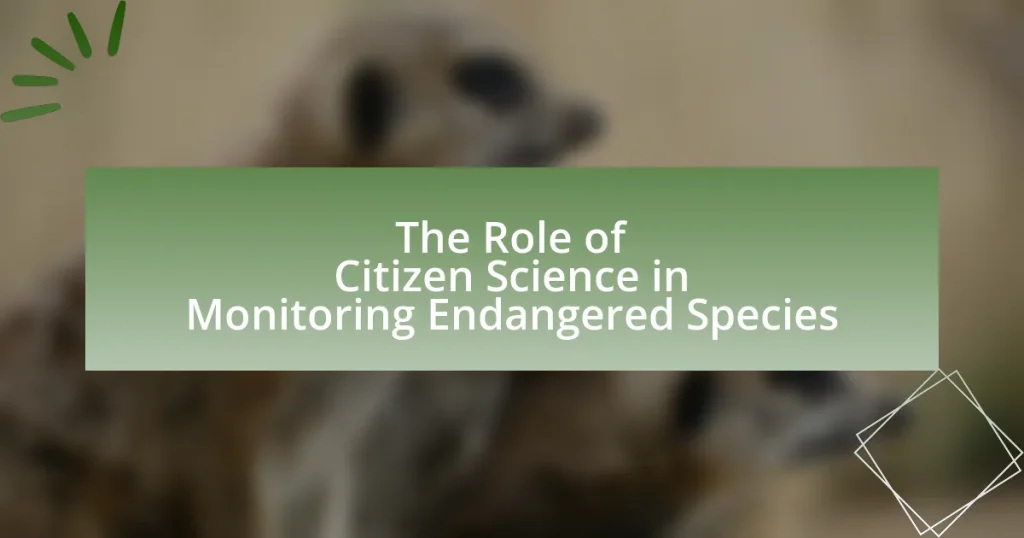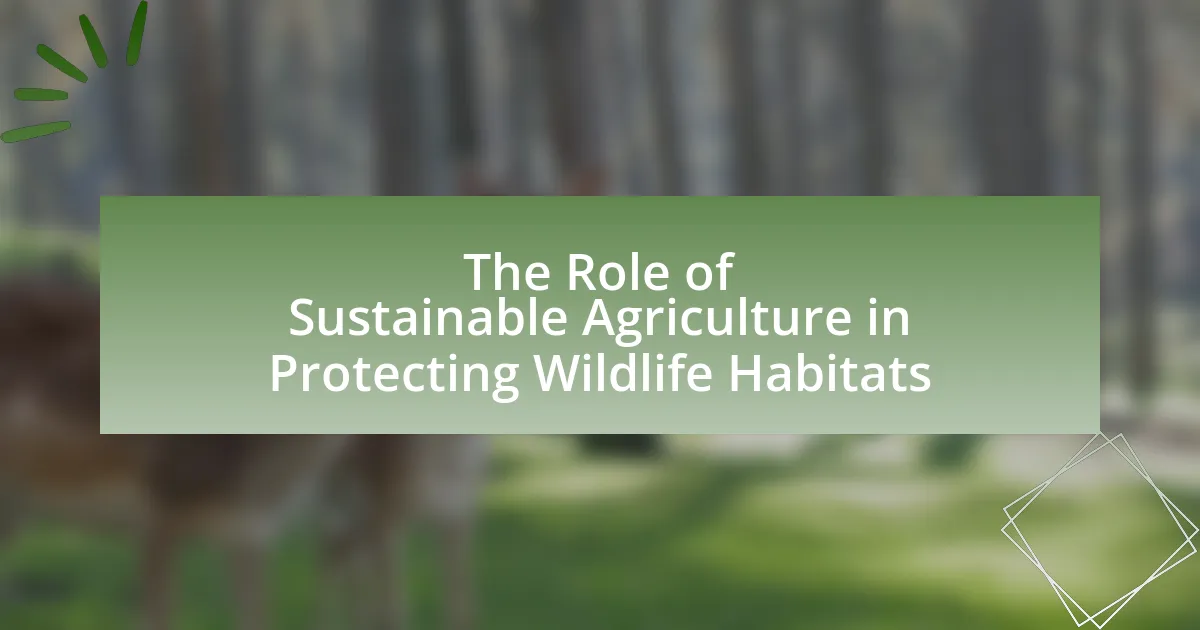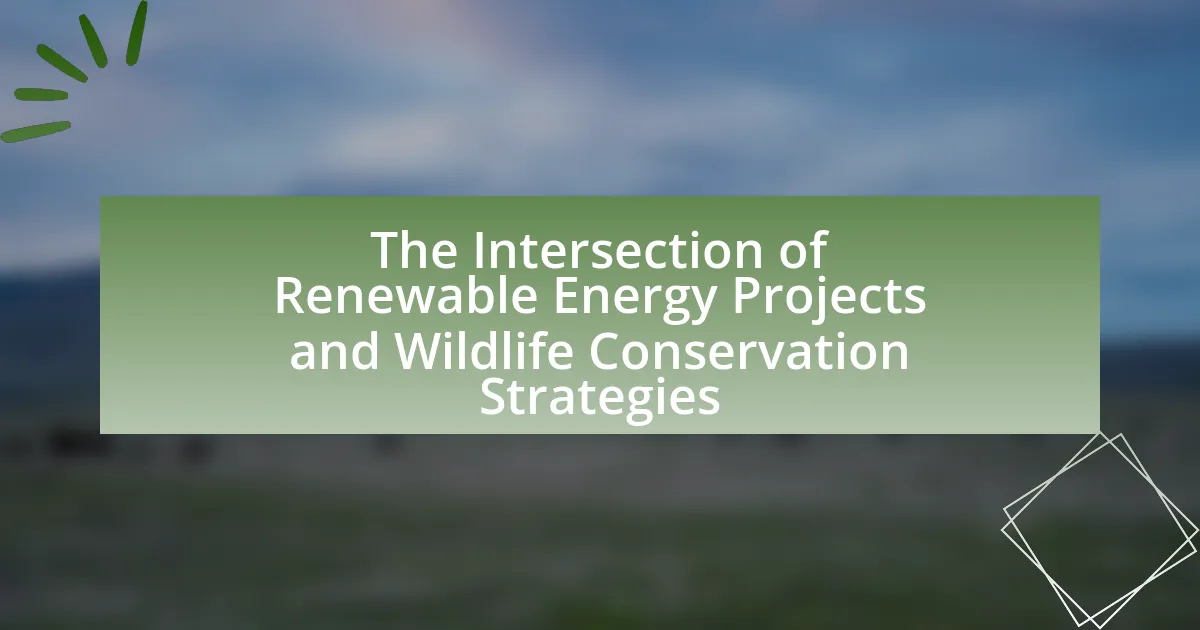Citizen science is a vital tool in monitoring endangered species, engaging the public in data collection and observation efforts that enhance the volume and diversity of information gathered. This article explores how citizen science contributes to data collection, the methods used by citizen scientists, and the reliability of their data compared to professional researchers. It also discusses the importance of citizen science for conservation efforts, its impact on public awareness, and the collaboration between communities and scientists. Additionally, the article addresses the challenges faced by citizen scientists, the role of technology in improving data collection and analysis, and successful examples of citizen science initiatives that have effectively contributed to conservation outcomes.

What is the role of citizen science in monitoring endangered species?
Citizen science plays a crucial role in monitoring endangered species by engaging the public in data collection and observation efforts. This involvement enhances the volume and diversity of data gathered, which is essential for tracking species populations and behaviors. For instance, projects like the Audubon Society’s Christmas Bird Count have mobilized thousands of volunteers, resulting in extensive data that informs conservation strategies. Additionally, citizen science initiatives often lead to increased public awareness and advocacy for endangered species, fostering a community-driven approach to conservation.
How does citizen science contribute to data collection for endangered species?
Citizen science significantly enhances data collection for endangered species by engaging the public in systematic observation and reporting. This approach allows for the gathering of large volumes of data across diverse geographic areas, which would be challenging for professional scientists to cover alone. For instance, projects like the Audubon Society’s Christmas Bird Count have mobilized thousands of volunteers, resulting in extensive datasets that track bird populations over decades, providing critical insights into species trends and habitat changes. Such contributions are vital for conservation efforts, as they help identify at-risk species and inform policy decisions based on real-time data.
What methods do citizen scientists use to gather data on endangered species?
Citizen scientists gather data on endangered species primarily through methods such as wildlife monitoring, data collection via mobile applications, and participation in organized surveys. Wildlife monitoring involves observing and recording species presence, behavior, and habitat conditions, often using standardized protocols to ensure data consistency. Mobile applications, like iNaturalist, enable citizen scientists to document sightings and share them with researchers, facilitating real-time data collection. Organized surveys, such as bird counts or plant surveys, allow volunteers to systematically collect data over specific areas and timeframes, contributing to larger datasets used for conservation efforts. These methods have been validated by studies showing that citizen-collected data can be as reliable as that gathered by professionals, enhancing the understanding of species distribution and population trends.
How reliable is the data collected by citizen scientists compared to professional researchers?
Data collected by citizen scientists can be reliable, but it often varies in quality compared to data gathered by professional researchers. Studies have shown that when citizen scientists are properly trained and follow standardized protocols, their data can match the accuracy of professional researchers. For instance, a study published in the journal “Frontiers in Ecology and the Environment” by Daniel J. Schneider et al. (2017) found that citizen-collected data on bird populations were comparable to those collected by experts, demonstrating that citizen science can effectively contribute to monitoring efforts. However, variability in training, experience, and adherence to scientific methods can lead to inconsistencies in data quality among citizen scientists.
Why is citizen science important for conservation efforts?
Citizen science is important for conservation efforts because it engages the public in data collection and monitoring, significantly enhancing the scope and scale of conservation initiatives. By involving volunteers in activities such as species identification and habitat assessments, citizen science projects can gather large amounts of data across diverse geographical areas, which would be difficult for professional scientists to achieve alone. For example, the Global Biodiversity Information Facility has shown that citizen-contributed data can improve species distribution models and inform conservation strategies, leading to more effective protection of endangered species.
What impact does citizen science have on public awareness of endangered species?
Citizen science significantly enhances public awareness of endangered species by actively involving individuals in data collection and research efforts. This engagement fosters a deeper understanding of biodiversity and conservation issues, as participants learn about the specific species they are studying and the threats they face. Research indicates that citizen science projects, such as the Audubon Society’s Christmas Bird Count, have increased public knowledge and concern for local wildlife, leading to greater advocacy for conservation measures. Additionally, studies show that participants in citizen science initiatives often share their experiences and findings within their communities, further amplifying awareness and encouraging collective action towards protecting endangered species.
How does citizen science enhance collaboration between communities and scientists?
Citizen science enhances collaboration between communities and scientists by actively involving local individuals in data collection and research efforts, fostering a shared sense of ownership and responsibility for environmental issues. This participatory approach allows scientists to access a broader range of data and insights from diverse geographic areas, which is particularly valuable in monitoring endangered species. For instance, studies have shown that citizen scientists can contribute significant amounts of data, such as species sightings and habitat conditions, which can lead to more comprehensive conservation strategies. Additionally, this collaboration builds trust and communication between scientists and communities, as local knowledge is integrated into scientific research, ultimately leading to more effective conservation outcomes.
What challenges do citizen scientists face in monitoring endangered species?
Citizen scientists face several challenges in monitoring endangered species, including lack of training, data reliability issues, and limited access to resources. The absence of formal training can lead to inconsistent data collection methods, which affects the quality and reliability of the information gathered. Additionally, citizen scientists may struggle with identifying species accurately, leading to potential misreporting. Limited access to necessary tools, such as technology for data recording or transportation to remote locations, further hampers their ability to effectively monitor these species. These challenges highlight the need for structured support and resources to enhance the contributions of citizen scientists in conservation efforts.
What are the common obstacles in data accuracy and reporting?
Common obstacles in data accuracy and reporting include data entry errors, inconsistent data formats, and lack of standardization in data collection methods. Data entry errors can arise from human mistakes during input, leading to inaccuracies. Inconsistent data formats hinder the ability to aggregate and analyze data effectively, as different contributors may use varying units or structures. Additionally, the absence of standardized protocols for data collection can result in discrepancies in the information gathered, affecting the reliability of the reported findings. These issues are particularly relevant in citizen science initiatives, where diverse participants may have varying levels of expertise and adherence to best practices in data collection.
How can citizen scientists overcome these challenges?
Citizen scientists can overcome challenges in monitoring endangered species by utilizing technology, collaborating with experts, and participating in structured training programs. Technology, such as mobile apps and online databases, facilitates data collection and sharing, making it easier for citizen scientists to contribute valuable information. Collaboration with researchers and conservation organizations provides access to resources, guidance, and validation of data, enhancing the credibility of their efforts. Structured training programs equip citizen scientists with the necessary skills and knowledge to effectively monitor species, ensuring that their contributions are scientifically sound and impactful.
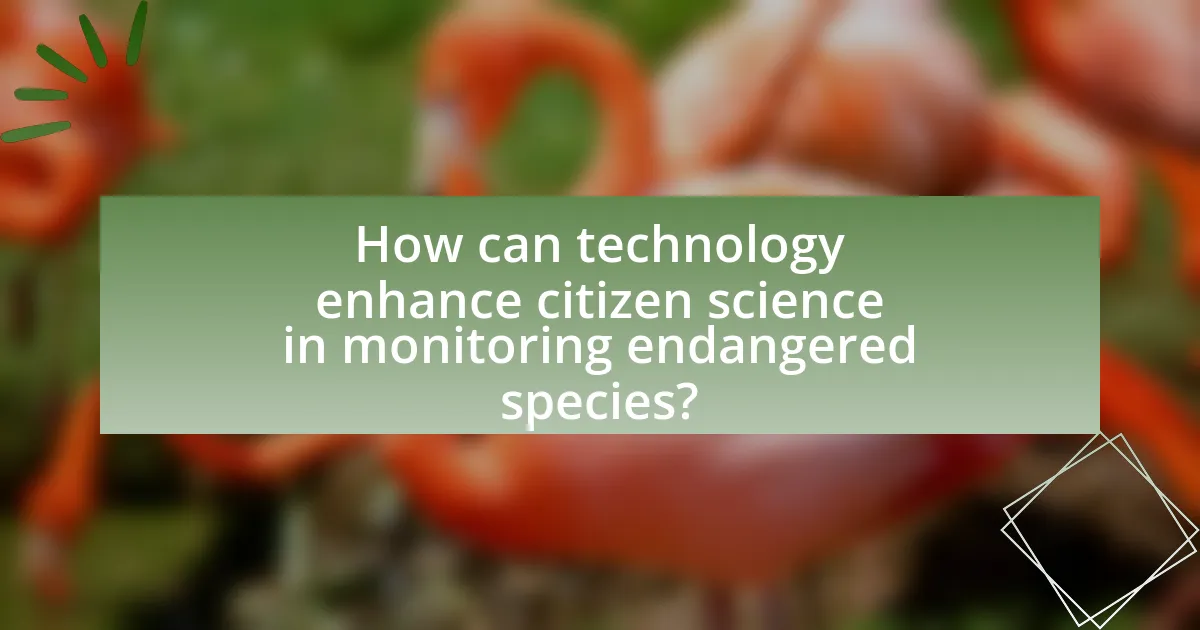
How can technology enhance citizen science in monitoring endangered species?
Technology enhances citizen science in monitoring endangered species by providing tools for data collection, analysis, and sharing. Mobile applications enable volunteers to report sightings and gather information in real-time, increasing the volume and accuracy of data collected. For instance, platforms like iNaturalist allow users to upload photos and location data, which are then verified by experts, creating a robust database for researchers. Additionally, remote sensing technologies, such as drones and satellite imagery, facilitate the monitoring of habitats and populations over large areas, offering insights that would be difficult to obtain through traditional methods. These technological advancements not only improve the efficiency of data collection but also foster community engagement and awareness about conservation efforts.
What tools and platforms are available for citizen scientists?
Citizen scientists have access to various tools and platforms designed to facilitate their contributions to research and data collection. Notable platforms include iNaturalist, which allows users to document and share biodiversity observations, and eBird, a platform specifically for birdwatching data collection. Additionally, Zooniverse offers a range of projects where volunteers can assist in data analysis across multiple scientific disciplines. These platforms provide user-friendly interfaces and community support, enabling citizen scientists to engage effectively in monitoring endangered species and contributing valuable data to conservation efforts.
How do mobile apps facilitate data collection for endangered species?
Mobile apps facilitate data collection for endangered species by enabling citizen scientists to report sightings, track behaviors, and document environmental conditions in real-time. These applications often include features such as GPS tracking, photo uploads, and species identification tools, which enhance the accuracy and efficiency of data gathering. For instance, platforms like iNaturalist and eBird allow users to contribute valuable information that researchers can analyze to monitor population trends and habitat changes. Studies have shown that citizen science initiatives leveraging mobile technology can significantly increase the volume of data collected, providing critical insights for conservation efforts.
What role do social media and online communities play in citizen science?
Social media and online communities play a crucial role in citizen science by facilitating collaboration, data collection, and awareness among participants. These platforms enable researchers to engage a broader audience, allowing individuals to contribute observations and data related to endangered species. For instance, projects like iNaturalist leverage social media to encourage users to share their wildlife sightings, which helps in tracking species distribution and population trends. Additionally, online communities foster knowledge sharing and provide educational resources, enhancing the overall effectiveness of citizen science initiatives.
How does technology improve data analysis in citizen science projects?
Technology enhances data analysis in citizen science projects by enabling efficient data collection, processing, and visualization. Advanced tools such as mobile applications and online platforms facilitate real-time data entry and sharing, allowing volunteers to contribute observations quickly and accurately. For instance, platforms like iNaturalist utilize GPS and image recognition technology to streamline species identification and data submission, significantly increasing the volume and quality of data collected. Furthermore, machine learning algorithms can analyze large datasets to identify patterns and trends that may not be apparent through manual analysis, thereby improving the overall understanding of species populations and their habitats. This integration of technology not only accelerates the data analysis process but also enhances the reliability of findings in monitoring endangered species.
What advancements in technology have made data analysis more accessible for citizen scientists?
Advancements in technology such as user-friendly software, mobile applications, and cloud computing have significantly enhanced data analysis accessibility for citizen scientists. User-friendly software like R and Python libraries provide intuitive interfaces and extensive documentation, enabling non-experts to perform complex analyses. Mobile applications facilitate real-time data collection and submission, allowing citizen scientists to contribute data from remote locations easily. Cloud computing platforms offer scalable storage and processing power, enabling collaborative analysis and sharing of large datasets. These technologies collectively empower citizen scientists by simplifying the data analysis process and fostering community engagement in scientific research.
How can machine learning assist in identifying species from citizen-collected data?
Machine learning can assist in identifying species from citizen-collected data by analyzing large datasets to recognize patterns and classify species accurately. Algorithms can process images, audio recordings, and textual descriptions submitted by citizens, enabling rapid identification of species based on features such as color, shape, and sound. For instance, convolutional neural networks (CNNs) have been successfully used to classify images of plants and animals, achieving accuracy rates exceeding 90% in some studies. This capability enhances the efficiency of biodiversity monitoring and supports conservation efforts by providing reliable data for endangered species assessments.
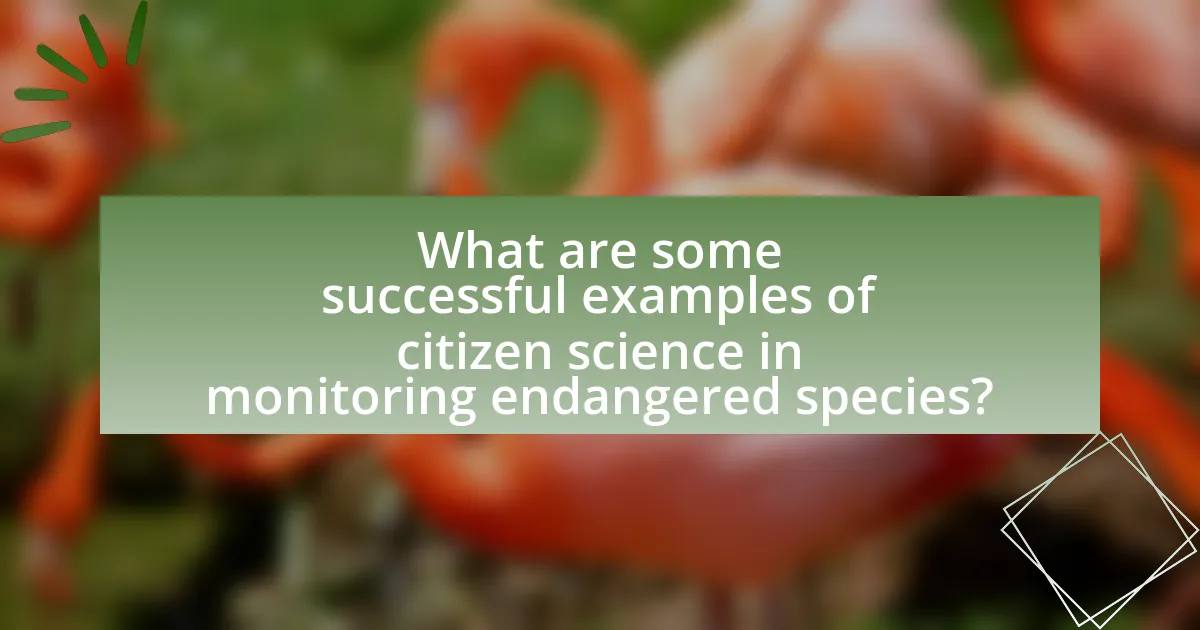
What are some successful examples of citizen science in monitoring endangered species?
Successful examples of citizen science in monitoring endangered species include the Great Backyard Bird Count and the Monarch Butterfly Citizen Science Project. The Great Backyard Bird Count, initiated in 1998, engages volunteers to count bird species in their backyards, providing critical data on bird populations and migration patterns, which has contributed to understanding declines in certain species. The Monarch Butterfly Citizen Science Project involves participants tracking the migration and breeding of monarch butterflies, helping researchers monitor population trends and habitat needs. These initiatives demonstrate the effectiveness of citizen involvement in gathering valuable ecological data, leading to informed conservation efforts.
What notable projects have effectively utilized citizen science for conservation?
Notable projects that have effectively utilized citizen science for conservation include the Audubon Society’s Christmas Bird Count, which has been conducted annually since 1900 and engages thousands of volunteers to collect data on bird populations across North America. Another significant project is the Monarch Watch program, which involves citizen scientists in tracking monarch butterfly migrations and contributing to research on their declining populations. Additionally, the iNaturalist platform allows users to document biodiversity by sharing observations of plants and animals, thereby contributing to conservation efforts and species monitoring. These projects demonstrate the power of community involvement in gathering critical data for conservation initiatives.
How did the involvement of citizen scientists impact the outcomes of these projects?
The involvement of citizen scientists significantly enhanced the outcomes of projects monitoring endangered species by increasing data collection efficiency and expanding geographic coverage. For instance, citizen scientists contributed to the collection of over 1.5 million observations in the “eBird” project, which helped track bird populations and inform conservation strategies. This large-scale participation not only provided valuable data but also fostered community engagement and awareness about endangered species, leading to more robust conservation efforts.
What lessons can be learned from successful citizen science initiatives?
Successful citizen science initiatives demonstrate the importance of community engagement and collaboration in data collection and analysis. These initiatives often lead to increased public awareness and support for conservation efforts, as seen in projects like the Audubon Society’s Christmas Bird Count, which has involved over 100 years of citizen participation, resulting in valuable data on bird populations and trends. Additionally, successful initiatives highlight the need for clear communication and training for volunteers, ensuring that data collected is reliable and scientifically valid, as evidenced by the success of the iNaturalist platform, which has facilitated over 20 million species observations globally. Lastly, successful citizen science projects often leverage technology, such as mobile apps and online platforms, to enhance participation and streamline data collection, exemplified by the use of smartphone applications in the FrogWatch USA program, which has engaged thousands of volunteers in monitoring amphibian populations.
What best practices should citizen scientists follow when monitoring endangered species?
Citizen scientists should follow systematic observation, accurate data collection, and ethical guidelines when monitoring endangered species. Systematic observation involves using established protocols to ensure consistency and reliability in data gathering. Accurate data collection requires using standardized tools and methods, such as GPS devices and field guides, to minimize errors. Ethical guidelines include respecting wildlife habitats, avoiding disturbance to the species being monitored, and adhering to local regulations. These practices enhance the quality of data collected, which is crucial for effective conservation efforts, as evidenced by studies showing that well-documented citizen science projects can significantly contribute to biodiversity monitoring and management.
How can citizen scientists ensure the accuracy and reliability of their data?
Citizen scientists can ensure the accuracy and reliability of their data by following standardized protocols and utilizing validated tools for data collection. Adhering to established methodologies minimizes variability and enhances consistency in data gathering. For instance, using GPS devices for location tracking and specific identification guides for species ensures precise and reliable observations. Additionally, participating in training sessions and workshops can improve skills and knowledge, further enhancing data quality. Research indicates that citizen science projects that implement rigorous training and standardized methods yield data comparable in quality to that collected by professional scientists, as demonstrated in studies like “The Role of Citizen Science in Biodiversity Monitoring” published in the journal Conservation Biology.
What ethical considerations should citizen scientists keep in mind during their work?
Citizen scientists should prioritize informed consent, data integrity, and respect for wildlife when conducting their work. Informed consent ensures that participants understand the purpose and potential impacts of their involvement, which is crucial for ethical engagement. Data integrity involves accurately reporting findings and avoiding manipulation, as this maintains the credibility of citizen science efforts. Respect for wildlife includes minimizing disturbance to habitats and adhering to regulations regarding endangered species, which is essential for conservation efforts. These considerations are supported by guidelines from organizations like the Citizen Science Association, which emphasizes ethical practices in citizen science projects.
